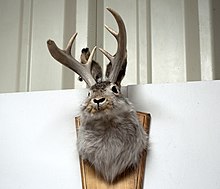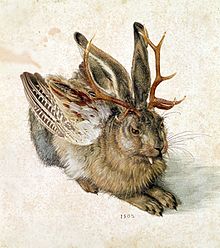The jackalope is a mythical animal of North American folklore (a fearsome critter) described as a jackrabbitwith antelope horns. The word jackalope is a portmanteau of jackrabbit and antelope. Many jackalope taxidermy mounts, including the original, are made with deer antlers.
In the 1930s, Douglas Herrick and his brother, hunters with taxidermy skills, popularized the American jackalope by grafting deer antlers onto a jackrabbit carcass and selling the combination to a local hotel in Douglas, Wyoming. Thereafter, they made and sold many similar jackalopes to a retail outlet in South Dakota, and another taxidermist continues to manufacture the horned rabbits in the 21st century. Stuffed and mounted, jackalopes are found in many bars and other places in the United States; stores catering to tourists sell jackalope postcards and other paraphernalia, and commercial entities in America and elsewhere have used the word jackalope or a jackalope logo as part of their marketing strategies. The jackalope has appeared in published stories, poems, television shows, video games, and a low-budget mockumentary film. The Wyoming Legislature has considered bills to make the jackalope the state's official mythological creature.
The underlying legend of the jackalope, upon which the Wyoming taxidermists were building, may be related to similar stories in other cultures and other historical times. Researchers suggest that at least some of the tales of horned hares were inspired by sightings of rabbits infected with the Shope papilloma virus. It causes horn- and antler-like tumors to grow in various places on a rabbit's head and body.
Folklorists see the jackalope as one of a group of tall tale animals, known as fearsome critters, common to North American culture since the turn of the twentieth century. These fabulous beasts appear in tall tales featuring hodags, giant snakes, fur-bearing trout, and many others. Some such stories lend themselves to comic hoaxing by entrepreneurs who seek attention for their own personal or their region's fortune.
Jackalope taxidermy mount in a restaurant in Kansas | |
| Grouping | Mythological hybrids |
|---|---|
| Sub grouping | Fearsome critter[1] |






No comments:
Post a Comment